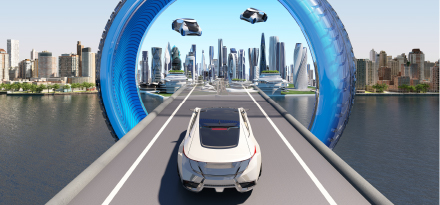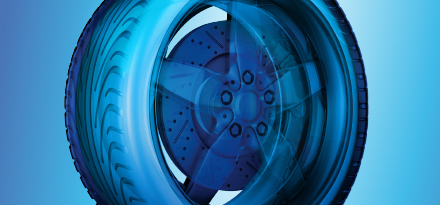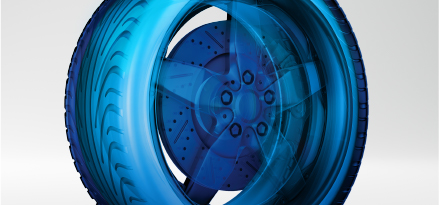
If you’ve got questions about the impact of electric vehicles (EV) on the automotive industry, you’re not alone. The global growth of EVs has created new challenges throughout the tire and vehicle industries. That’s why ExxonMobil has undertaken significant testing to better understand how air retention affects EV tire performance. Combining these test results with more than 80 years of experience in the industry, our scientists and engineers can provide well-informed answers to the common questions we’re all facing today within a changing mobility marketplace.
Yes, tire inflation does affect battery range. In fact, dissipated energy due to rolling resistance is 4 times greater for electric cars than for internal combustion engine (ICE) vehicles. To measure this impact, ExxonMobil performed in-depth, in-use tests and determined that proper air pressure can extend battery range by 3 to 7%. Because an electric car has a much more efficient powertrain, any losses induced by underinflated tires will probably have a bigger impact on the energy efficiency of the vehicle and, therefore, on the range of its battery.
Electric cars definitely are tougher on tires. They’re heavier – typically +300 kg/650 pounds heavier – than cars with internal combustion engines, due to the large battery. They also deliver 100% torque from standstill. These factors increase stress, which can shorten tire life. That’s why air retention is even more important for tires on electric cars. Under-inflation can reduce tire lifespan on any type of vehicle by as much as 45%.
Electric cars don’t typically require special tires. That said, high-performance tires, which can be more expensive, are more able to handle the added stress and demands of electric cars. Tires made with haloybutyl innerliners, which increase air retention, will last longer and perform better.
Underinflated tires require extra energy to roll. Why? Rolling resistance. Rolling resistance is the energy your vehicle needs to send to your tires to maintain movement at a consistent speed over a surface. The more rubber that meets the road, the more resistance. Dissipated energy due to rolling resistance is four times greater for electric vehicles. That’s why improved air retention is key to maintaining efficiency and performance gains in electric cars.
Electric cars put greater stress on tires. That’s why tire air retention is especially important for electric cars. ExxonMobil on-road EV tests show 5 to 17% reduction in tire life, depending on air loss rate and maintenance, as well as 3 to 7% reduction in battery range. It’s clear that EV tires need improved air retention to maintain consistent in-use performance over the life of the tire.
No doubt about it – longer maintenance intervals make air retention more important for electric car tires. An electric car typically only needs maintenance once per year – no oil changes – but tires lose air pressure every day. In fact, they lose an average of 4.8% per month in use. That means 44.26% air loss in one year! So electric car tires need to retain tire pressure for longer periods of time. Higher quality tires that include halobutyl innerliners can minimize air loss to help maintain optimal tire pressure.
There are no legal standards right now to institute a maximum monthly air loss rate of 1.8%, but OEMs are pushing and regulators are aware of the impact. Creating a standard is the simplest and most direct way to improve tire efficiency today without any additional impact to tire performance. Inflation Pressure Loss Rate (IPLR) measures the percentage of air loss per month and varies widely depending on the composition and gauge of tire innerliners. Creating a standard IPLR will help boost the energy savings created by electric cars. A well-known solution to improving air retention is to increase the halobutyl content in the tire innerliner.
It’s a common misconception that a vehicle’s TPMS prevents or eliminates under-inflation. It doesn’t. The system is primarily intended to prevent catastrophic failures when there is a major loss of pressure. TPMS warning lights are typically set at -25% US and AP, -20% EU, which is well below the level at which tire performance is harmed. It is useful as a reminder to check tires, but it has no capacity to actually help tires retain air. In fact, car owners might even be checking their tires less frequently because they assume there is nothing wrong unless the TPMS warning light activates. Even on cars that have a TMPS, drivers should continue to check the tire pressure at least once a month.
Maintaining proper tire inflation is more of a safety issue with electric cars because their heavier weight and maximum torque create handling and traction challenges. Properly inflated tires help improve handling and traction for more secure driving and braking and passenger safety. Industry data shows that properly inflated tires can improve braking distance by as much as 7%.
There are three main factors that affect tire air retention: innerliner permeability, thickness and liner endpoint. Tire manufacturers want as little permeability as possible, which is affected mainly by polymer type and content. Next, air retention is directly proportional to innerliner thickness. The thicker, the better. Thin spots also decrease air retention. Finally, air retention is best when the liner ending is located outside the rim. Because halobutyl rubber delivers advanced air-barrier technology, it maximizes performance in these three critical areas.
Find out if the tires are made with quality halobutyl innerliners, which are capable of improving air retention through advanced air-barrier technology. The ability of a tire to hold pressure over time affects all other tire performance attributes. ExxonMobil in-use road testing demonstrates that proper air retention can extend an electric car’s tire life by up to 17%. When buying tires, always ask, “How well do these tires hold air?”
In a first-of-its-kind study, ExxonMobil engineers conducted real-world, on-road tests in Texas to measure the impact of tire air loss on energy consumption and vehicle range in electric cars. The study followed three identical electric cars, each with a different air-loss rate. Each car traveled more than 5,400 miles in a range of environments. The data shows that air loss, depending on rate and maintenance, can reduce tire life by 5 to 17%. Air loss can reduce battery range by 3 to 7%.




